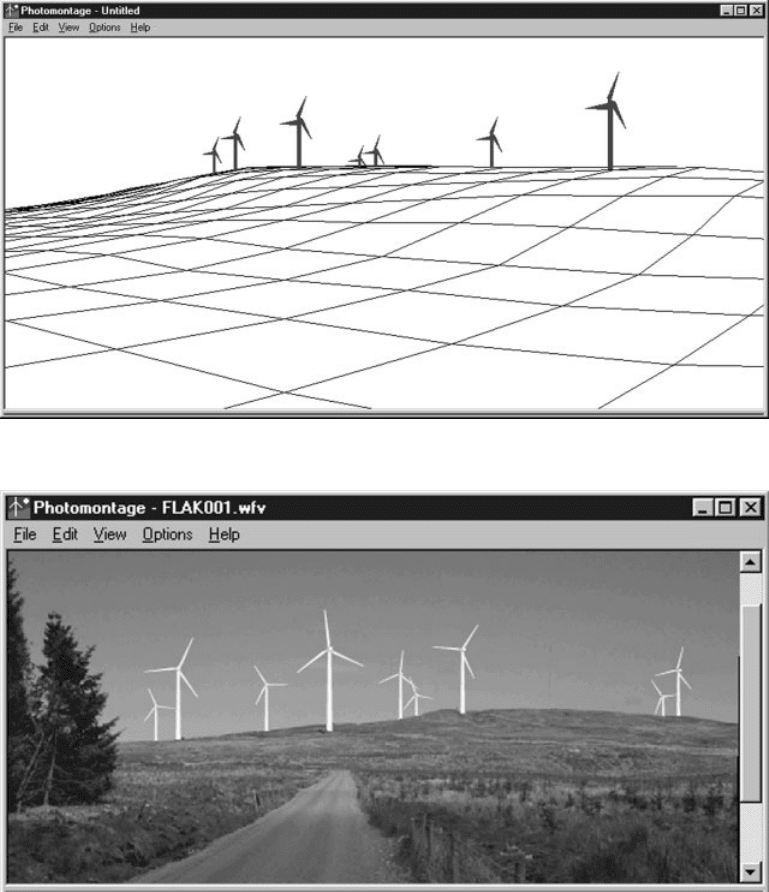Burton T. (et. al.) Wind energy Handbook
Подождите немного. Документ загружается.


Viewpoint analysis is based on sele cting a number of important locations from
which the wind farm is visible and applying professional judgement using quanti-
tative criteria to assess the visual impact. The viewpoints are selected in consulta-
tion with the civic planning authorities and for a large wind farm up to 20 locations
may be chosen. Although approaches vary, the assessment may involve considera-
tion of three aspects: (1) the sensitivity of the landscape, (2) the sensitivity of the
viewpoint, and (3) the magnitude of the change of view. Thus, for example, the
landscape within a National Park will be of ‘high’ sensitivity while a landscape
with existing discordant features such as old quarry workings may have a ‘low’
sensitivity. Similarly a viewpoint where the land use is residentia l or has high
recreational value may have a ‘high’ sensitivity, while a viewpoint that is used only
for indoor employment (e.g., a local industrial estate), might be considered to have
a ‘low’ sensitivity. The magnitude of the impact can be described in a similar
manner depending, for example, on the number of turbines visible, the distance to
the wind farm and the prominence of the development. The overall significance of
the impact is then assessed, again using quantitative terminology (such as substan-
tial, moderate, slight, negligible, etc.), by combining these factors. Where a substan-
tial impact is identified, acceptability will depend on whether it is considered that
the wind farm will have a detrimental effect on the landscape quality.
Figure 9.7 Example of Zone of Visual Impact of a Wind Farm (Courtesy of ReSoft www.re-
soft.co.uk) Based upon the Ordnance Survey Mapping on behalf of The Controller of Her
Majesty’s Stationary Office # Crown Copyright MC 100014737
VISUAL AND LANDSCAPE ASSESSMENT 525
Publisher's Note:
Permission to
reproduce this image
online was not granted
by the copyright holder.
Readers are kindly
requested to refer to
the printed version of
this article.

Figure 9.8 shows a typical wireframe image generated from a viewpoint and
Figure 9.9 shows a photomontage. Both of these images were generated using wind
farm design software. Wireframe representations, provide an accu rate impression
of turbine position and scale while photomontages are the normal tool used to give
an overall impression of the visual effect of a wind farm. Videomontages have been
proposed in order to give an impression of the movement of turbine blades but this
tool is not yet in regular use.
Figure 9.8 Example of Wire Frame View (Courtesy of ReSoft www.resoft.co.uk)
Figure 9.9 Example of Photomontage (Courtesy of ReSoft www.resoft.co.uk)
526
WIND TURBINE INSTALLATIONS AND WIND FARMS
9.2.4 Shadow flicker
Shadow flicker is the term used to describ e the stroboscopic effect of the shadows
cast by rotating blades of wind turbines when the sun is behind them. The shadow
can create a disturbance to people inside buildings exposed to such light passing
through a narrow window. Although considered to be an important issue in
Europe, and recognized in the operation of traditional windmills (Verkuijlen and
Westra, 1984) shadow flicker has not generally been recognized as significant in the
USA (Gipe, 1995).
The frequencies that can cause disturbance are between 2.5–20 Hz. The effe ct on
humans is similar to that caused by changes in intensity of an incandescent electric
light due to variations in network voltage from a wind turbine (see Section 10.5.1).
In the case of shadow flicker the main concern is variations in light at frequencies of
2.5–3 Hz which have been shown to cause anomalous EEG (elec troencephalogram)
reactions in some sufferers from epilepsy. Higher frequencies (15–20 Hz) may even
lead to epileptic convulsions. Of the general population, some 10 percent of all
adults and 15–30 percent of children are disturbed to some extent by light
variations at these frequencies (Verkuijlen and Wes tra, 1984).
Large modern three-bladed wind turbines will rotate at under 35 r.p.m. giving
blade-passing frequencies of less than 1.75 Hz, wh ich is below the critical frequency
of 2.5 Hz. A minimum spacing from the nearest turbines to a dwelling of 10 rotor
diameters is recommended to redu ce the duration of any nuisance due to light
flicker (Taylor and Rand, 1991). However , a spacing of this magnitude is likely to be
required in any event by noise constraints and to avoid visual domination.
9.2.5 Sociological aspects
There are a number of computer-based tools available for quantifying visual effects
and landscape architects and planners have developed techniques to place quanti-
tative measures on visual impact using professional judgement. However, publi c
attitudes, which ultimately determine whether a wind farm may be constructed, are
influenced by many more complex factors. Public attitudes to wind farms have
been studied on a number of occasions (e.g., ETSU, 1993, 1994) and Gipe (1995)
discusses this subject in considerable detail. In general, the large majority of people
approve of wind farms after they have been constructed although a significant
minority remains opposed to them. In particular, there is the difficult issue that
some local residents consider they are paying a high cost for a benefit, either
financial or environmental, which accrues to others. The financial benefits may be
shared with the community in a number of ways including by the development of
co-operative or community-owned wind farms, while the environmental issue has
to be addressed by consultation. Also, it is suggested that stationary wind turbines
are less acceptable than those rotating and so maintaining high availability with a
low cut-in wind speed is likely to improve public perception.
VISUAL AND LANDSCAPE ASSESSMENT 527

9.3 Noise
Noise from wind turbines is often perceived as one of the more significant environ-
mental impacts (Wagner, Bareis and Guidati, 1996). During the early development
of wind energy, in the 1980s, some turbines were rather noisy and this led to justified
complaints from those living close to them. However, since then, there has been very
considerable development both in techniques for reducing noise from wind turbines
and in predicting the noise nuisance a wind farm will create.
The UK document Planning Policy Guidance Note (Department of the Environ-
ment, 1993) suggests that:
‘A planning application for any wind-farm development could usefully be
accompanied by the following information regarding details of the proposed
turbine(s) and pr edicted noise levels:
• predicted noise levels at specific properties closest to the wind farm over the most
critical range of wind speeds;
• measured background noise levels at the properties and wind speeds outlined
above;
• a scale map showing the proposed wind turbine(s), the prevailing wind condi-
tions, nearby existing developments;
• results of independent measurements of noise emission from the proposed wind
turbine including the sound power and narrow-band frequency spectrum; in the
case of a prototype turbine where no measurements are available, predictions
should be made by comparison with similar machines.’
9.3.1 Terminology and basic concepts
Two distinctly different measures are used to describe wind turbine noise. These
are the sound power level L
W
of the source (i.e., the wind turbine) and the sound
pressure level L
P
at a location. Because of the response of the human ear, a
logarithmic scale is used based on reference levels that correspond to the limit of
hearing. The units of both L
P
and L
W
are the decibel (dB).
A noise source is described in terms of its sound power level, L
W
:
L
W
¼ 10 log
10
W
W
0
(9:4)
where W is the total sound power level emitted from the sour ce (in Watts) and W
0
is a reference value of 10
12
W.
The sound pressure level L
P
is defined as
L
P
¼ 10 log
10
P
2
P
2
0
!
(9:5)
528 WIND TURBINE INSTALLATIONS AND WIND FARMS

where P is the RMS value of the sound pressure and P
0
is a reference value of
2 3 10
5
Pa.
By simple algebraic manipulation it may be seen that the addition of n sound
pressure levels (expressed in dB) is carried out as shown:
L
Pn
¼ 10 log
10
X
j¼n
j¼1
10
L
P( j)
=10
(9:6)
Thus, adding two sound pressure levels of the same magnitude results in an
increase of 3 dB. Table 9.2 gives an indication of the typical ran ge of sound pre ssure
levels.
The human ear is capable of detecting sounds between 20 Hz and 20 kHz and
spectral analysis is typically unde rtaken over this range. A narrow-band spectrum,
with a defined bandwidth of measurement, gives the fullest information of the
signal and may be used to detect particular tones. However, it is conventional to
use octave and 1/3-octave bands for broadband analysis. The upper frequency of
an octave band is twice that of the lower frequency while for the 1/3-octave band
the upper frequency is
ffiffiffi
2
3
p
times the lower frequency.
It is common to weight the measurements to reflect the response of the human
ear with frequency. This is done by applying the so-called A-weighted filter.
Measurements made with this filter are referred to as dBA or dB(A). Table 9.3
shows the centre frequencies of the octave bands together with the A-weighting in
dB. It may be seen that frequencies below 250 Hz and above 16 kHz are heavily
attenuated.
An equivalent sound pressure level L
eq,T
is the value of a continuous steady
sound that, within the specified time interval (T) has the same me an square sound
pressure level as the sound under consid eration which varies with time (Interna-
tional Energy Agency, 1994)
L
eq,T
¼ 10 log
10
1
T
ð
T
0
P
2
P
2
0
dt
!
(9:7)
A similar calculation may be undertaken using A–weighted values to give L
Aeq,T
Table 9.2 Examples of Sound Pressure Levels
Example Sound pressure level
(dB(A))
Threshold of hearing 0
Rural night time background 20–40
Busy general office 60
Inside factory 80–100
Jet aircraft at 100 m 120
Wind farm at 350 m 35–45
NOISE 529

L
Aeq,T
¼ 10 log
10
1
T
ð
T
0
P
2
A
P
2
0
dt
!
(9:8)
where L
Aeq,T
is the equivalent continuous A-weighted sound pressure level deter-
mined over time T and P
A
is the instantaneous A-weighted sound pressure.
The exceedance level, L
A90
, is defined as the A-weighted sound pressure level
which is exceeded for 90 percent of the time. Some planning authoritie s prefer the
use of the L
A90
sound pressure level, particularly for measurements of backgrou nd
noise, as the L
eq
measurement may be heavily influenced by short-term effects such
as passing aircraft or traffic. A wind farm is a fairly constant source of noise and so
its contribution to the L
A90
sound pressure level (measured over a 10 min period) is
likely to be some 1.5–2.5 dB(A) less than to the 10 min L
Aeq
value (ETSU, 1997a).
The sound intensity I is the power transmitted through a unit area, A,
I ¼
W
A
(9:9)
and far from the source of sound with a uniform flux
I ¼
P
2
Z
0
(9:10)
where P is the RMS value of the sound pressure level, and Z
0
is the characteristic
acoustic impedance.
Choosing a suitable value for I
ref
(10
12
W=m
2
), the sound pressure level may be
expressed in terms of sound intensity as
L
P
¼ 10 log
10
I
I
ref
(9:11)
For spherical spreading
Table 9.3 Centre Frequency of Oc-
tave Bands and A-weighting
Octave band centre
frequency (Hz)
A-weighting (dB)
16 56.7
31.5 39.4
63 26.2
125 16.1
250 8.6
500 3.2
1000 0.0
2000 1.2
4000 1.0
8000 1.1
16000 6.6
530
WIND TURBINE INSTALLATIONS AND WIND FARMS

I ¼
W
4r
2
(9:12)
where r is the distance from the source.
Hence, under conditions of ideal spherical spreading
L
P
¼ 10 log
10
W
4r
2
10
12
¼ L
W
10 log
10
(4r
2
)(9:13)
and similarly, if hemispherical spreading is assumed
L
P
¼ 10 log
10
W
2r
2
10
12
¼ L
W
10 log
10
(2r
2
)(9:14)
Sound pressure level, from a point source, decays with distance according to the
inverse square law under both spherical and hemi-spherical spreading assumptions.
Hence for each doubling of distance the sound pressure level is reduced by 6 dB.
For a line source of noise the sound pressure level is given by
L
P
¼ 10 log
10
L
wl
2r10
12
¼ L
wl
10 log
10
(2r)(9:15)
(L
wl
is the sound power level per unit length of the source.) Hence for cylindrical
spreading the decay is only proportional to distance, resulting in a 3 dB reduction of
sound pressure level for each doubling of distance per pendicular to the line source.
9.3.2 Wind-turbine noise
Noise from wind turbines is partly mechanical, and partly aerodynamic.
Mechanical noise is generated mainly from the rotating machinery in the nacelle
particularly the gearbox and generator although there may also be contributions
from cooling fans, auxiliary equipment (such as pumps and compressors) and the
yaw system. Mechanical noise is often at an identifiable frequency or tone (e.g.,
caused by the meshing frequency of a stage of the gearbox). Noise containing
discrete tones is more likely to lead to complaints and so attracts a 5dB penalty in
many noise standards. Mechanical noise may be air-borne (e.g., the cooling fan of
an air-cooled generator) or transmitted through the structure (e.g., gear box meshing
which is transmitted through the gearbox casing, the nacelle bed-plate, the blades
and the tower).
Pinder (1992) is quoted by Wagner, Bareis and Guidati (1996) as giving the values
of sound power level as shown in Table 9.4 for a 2 MW experimental wind turbine.
It may be seen that the gearbox is the dominant noise source through structure-
borne transmis sion.
Techniques to reduce the mechanical noise generated from wind turbines include
careful design and machining of the gearbox, use of anti-vibration mountings and
couplings to limit structure-borne noise, acoustic damping of the nacelle, and liquid
cooling of the generator (see Section 7.4.8).
Aerodynamic noise is due to a number of causes (ETSU, 1997a):
NOISE 531

• low-frequency noise,
• inflow turbulence noise,
• airfoil self noise.
Low-frequency noise is caused by changes in the wind speed experienced by the
blades due to the presence of the towe r or wind shear. Although this effect is very
pronounced with downwind turbines it is also signific ant with upwind machines.
The spectrum of the noise is dominated by blade-passing frequency (typically up to
3 Hz) and its harmonics (typically up to 150 Hz). It may be seen from Table 9.3 that
the A-weighted filter heavily attenuat es these frequencies and so this source does
not make a major contribution to audible noise. However, it was reported that
experimental, downwind turbines, constructed in the 1980s excited low-frequency
vibrations in adjacent buildings. For upwind turbines increasing the clearance
between the blades and tower will reduce this effect. Hubbard and Shephard
(Spera, 1994) show interesting experimental evidence of low-frequency noise from a
large 80 m diameter downwind turbine and provide a comparison with a 90 m
diameter upwind machine.
Inflow turbulence creates broadband noise as the blades inte ract with the eddies
caused by atmospheric turbulence. It generates frequencies up to 1000 Hz which
are perceived by an observer as a ‘swishing’ noise. Turbulent inflow noise is
considered to be influenced by the blade velocity, airfoil section and turbulence
intensity. Wagner, Bareis and Guidati (1996) describe this phenomenon in some
detail, remarking that it is not yet fully understood, and quote the results of one
field experiment where the sound pressure level actually decreased with increasing
turbulence intensity.
Airfoil self-noise is generated by the airfoil itself, even in steady, turbulent-
free flow. It is typically broadband although imperfections in the blade surface may
generate tonal components. The main types of airfoil self-noise include the
following.
Trailing edge nois e. This is perceived as a broadband swishing sound with frequen-
cies in the range 750–2000 Hz. It is due to interaction of the turbul ent boundary
Table 9.4 Sound Power Levels of Mechanical Noise of a 2 MW Experi-
mental Wind Turbine (after Wagner, Bareis and Guidati, 1996)
Element Sound power level
(dB(A))
Air-borne or structure-borne
Gearbox
Gearbox
97.2
84.2
Structure-borne
Air-borne
Generator 87.2 Air-borne
Hub (from gearbox) 89.2 Structure-borne
Blades (from gearbox) 91.2 Structure-borne
Tower (from gearbox) 71.2 Structure-borne
Auxiliaries 76.2 Air-borne
532
WIND TURBINE INSTALLATIONS AND WIND FARMS
layer with the trailing edge of the blade. Trailing edge noise is a major source of
higher frequency noise on wind turbines.
Tip noise. The literature is not clear as to whether three-dimensional tip effects are a
major contributor to wind turbine noise. However, the majority of the blade noise,
as well as the turbine power, emanates from the outer 25 percent of the blade and
so there has been very considerable investigation of nove l blade tips to reduce
noise. Imperfections in the blade shape due to tip-brakes or other control surfaces
are another potential source of noise.
Stall effects. Blade stall causes unsteady flow around the airfoil which can give rise
to broadband sound radiation.
Blunt trailing edge noise. A blunt trailing edge can give rise to vortex shedding and
tonal noise. It can be avoided by sharpening the trailing edge but this has implica-
tions for manufacturing and erection.
Surface imperfections. Surface imperfections such as those caused by damage during
erections or due to lightning strikes can be a significant source of tonal noise.
The obvious approach to reducing aerodynamic noise is to lower the rotational
speed of the rotor, although this may result in some loss of energy. The ability to
reduce noise in low wind-speed conditions is a major benefit of variable-speed or
two-speed wind turbines. An alternative technique would be to reduce the angle of
attack of the blade although again with a potential loss of energy.
Stiesdal and Kristensen (1993) provide a comprehensive description of noise
control methods applied to a 300 kW stal l-regulated wind turbine. The gearbox was
identified as an important source of tonal, mechanical noise. Control measures
included detailed modifications to the design and manufacture of the gears and an
additional insulating covering over the gearbox housing. Air-borne mechanical
noise was minimized by total enclosure of the nacelle and careful design of sound
baffles in the ventilation openings. Structure-borne noise was reduced by rubber
mounting both the gearbox and generator and using a rubber coupling on the high-
speed shaft. The long low-speed shaft (2 m) reduced the drive train vibrations
transmitted to the rotor. Tip noise was minimized by the use of a ‘tip torpedo’
to control the tip-vortex while trailing-edge noise was controlled by specifying a
1–2 mm traili ng edge thickness. Stall noise was reduced by using a turbulator strip
on the leading edge of the blades near the tip that init iated stall in a controlled
manner. Overall these measures resulted in a reduction of the sound power level of
3–4 dB and the elimination of significant tones. The most important noise control
methods were considered to be the tip modification, the controlled stall and the
gearbox improvements. The measured sound power level of the improve d wind
turbine was 96 dB(A) at a wind speed of 8 m/s (measured at 10 m height). This was
an impressive improvement as typical sound power levels of a modern 600 kW
wind turbine may be up to 100 dB(A) at a wind speed of 8 m/s (measured at 10 m
height) increasi ng by 0.5–1 dB(A) per m/s.
NOISE 533

9.3.3 Measurement, prediction and assessment of wind-farm noise
The sound power level of a wind turbine is normally determined by field experi-
ments. These were originally specified in the IEA Recommended Practice (Interna-
tional Energy Agency, 1994) but are now described in an international standard (BS,
1999, IEC, 1998). Outdoor experiments are necessary because of the large size of
modern wind turbines and the necessity to determine their noise performance
during operation. The sound power level cannot be measured directly but is found
from a series of measurements of sound pressure levels made around the turbine at
various wind speeds from which the backgrou nd sound pressure levels have been
deducted. The method provides the apparent A-weighted sound power level at a
wind speed of 8 m=s, its relationship with wind speed and the directivity of the
noise source for a single wind turbine. It does not distinguish between aerodynamic
and mechanical noise although there is a method proposed to determine if tones are
‘prominent’. In addition to A-weighted sound pressure levels, octave or 1/3-octave
and narrow-band spectra are measured.
The measurements are taken at a distance, R
0
, from the base of the tower:
R
0
¼ H þ
D
2
(9:16)
where H is the hub height and D is the diameter of the rotor. This distance is a
compromise to allow an adequate distance from the source but with minimum
influence of the terrain, atmospheric conditions or wind-induced noise. The micro-
phones are located on boards at ground level so that the effect of ground
interference on tones may be evaluated. Four microphone positions are used as
shown in Figure 9.10.
Simultaneous A- weighted sound pressure level measurements (more than 30
measurements each of 1–2 min duration) are taken with wind speed. All wind
speeds are corrected to a reference height of 10 m with a terrain roughness length of
z
0
¼ 0:5 m. The preferred method of determining wind speed, when the turbine is
operating, is from the electrical power output of the turbine and the power curve.
The main sound pressure level measurement is that of the downwind positi on
while the other thr ee microphones are used for determining directivity. Measure-
ments are taken with and without the turbine operating over a range of at least
4m=s which includes the 8 m=s reference. The sound pressure levels, with and
without the turbine in operation, are then plotted against wind speed and linear
regression used to find the 8 m=s values. The method of bins may be used to group
the data. The sound pressure level of the turbine alone at the reference conditions,
LA
eq,ref
, is then calculated using
L
Aeq,ref
¼ 10 log
10
(10
L
SþN
=10
10
L
N
=10
)(9:17)
where L
SþN
is the sound pressure level of the wind turbine and the background
sound at 8 m=s, and L
N
is the sound pressure level of the background with the
wind turbine parked at 8 m=s.
534 WIND TURBINE INSTALLATIONS AND WIND FARMS
